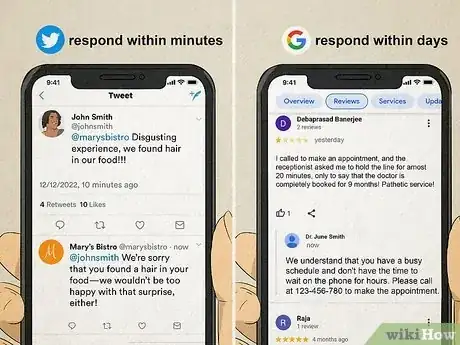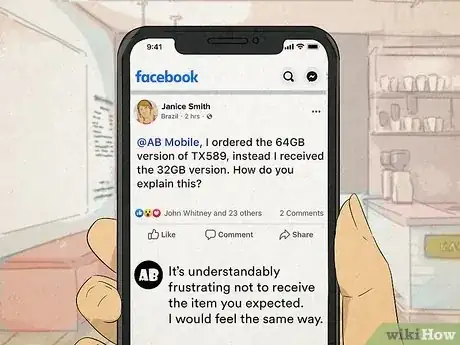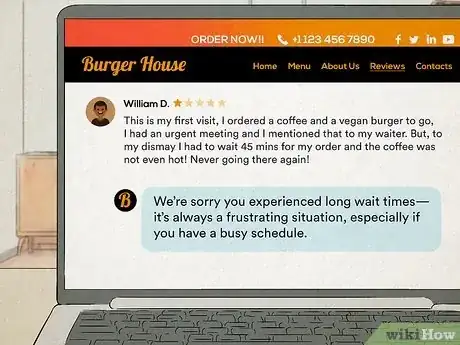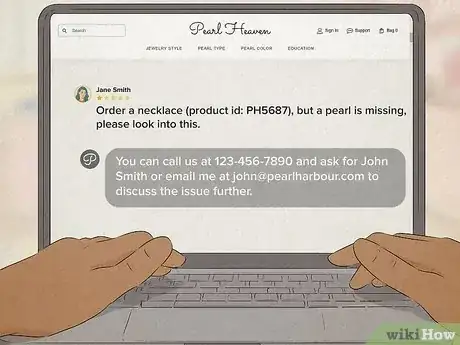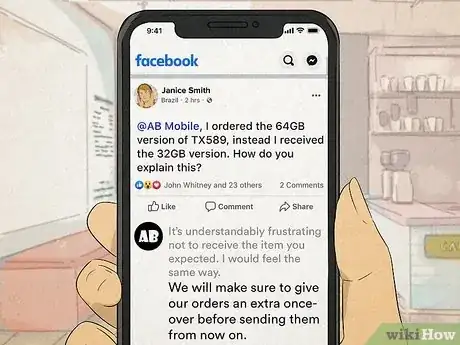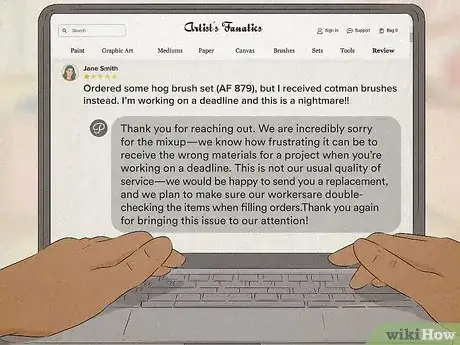This article was co-authored by wikiHow Staff. Our trained team of editors and researchers validate articles for accuracy and comprehensiveness. wikiHow's Content Management Team carefully monitors the work from our editorial staff to ensure that each article is backed by trusted research and meets our high quality standards.
There are 7 references cited in this article, which can be found at the bottom of the page.
Learn more...
Most businesses have to deal with reviews from customers. While one looks forward to positive reviews, it’s a bit tougher to deal with negative reviews. Sometimes a customer will respond to a one-off mistake, such as receiving the wrong item; other times it will be a systemic issue, such as regular long wait times for your products or services; and sometimes the complaint won’t be your fault at all, such as a customer misunderstanding what they had ordered in the first place. But whether or not the complaint is your fault, it’s important to respond to negative reviews in a professional manner. Never fear—we’re here to help you do just that!
Steps
Respond in a timely fashion.
-
A quick response will help your customers feel appreciated and respected. Plus, it will help avert any sense that you’re ignoring them. A timely review can even help dissuade future negative reviews in some instances. Many customers are less likely to leave such reviews if they see that they have an audience because they want to avoid confrontation.[1] X Research source
- On Twitter, you should respond within minutes.
- On Google, you should respond within days.
Empathize with the person’s complaint.
-
Openly acknowledge the customer’s pain point. This validates their feelings. Empathizing with the person shows that you understand where they’re coming from.[2] X Research source
- For example, "We understand that you have a busy schedule and don't have the time to wait on the phone for hours."
- Or, "It's understandably frustrating not to receive the item you expected. I would feel the same way."
Apologize for their pains.
-
Apologizing can help diffuse the situation. It’s important to stay polite and keep your ego out of this apology. Even if the customer’s pain point isn’t your fault, you can find ways to say "sorry" without taking full responsibility—in some cases, saying "sorry" is as much about acknowledging the person's pain points as anything else.[3] X Research source
- If somebody is complaining about long lines, you might say, "We're sorry you experienced long wait times—it's always a frustrating situation, especially if you have a busy schedule."
Get specific.
-
Offer a specific reason why you're sorry. Apologizing for "the inconvenience" sounds vague and insincere. Responding in detail lets the customer know that you listened and heard them.[4] X Research source
- "We're sorry that you found a hair in your food—we wouldn't be too happy with that surprise, either!"
- "We're sorry to hear that the pin was smaller than you expected. We do have some larger pins, if you would be interested in those."
Be judicious in your apology.
-
Repeatedly saying that you’re sorry can come across as unprofessional or insincere. This includes any explanations you provide: If the slip-up was on your end, there might be a legitimate reason that the mistake happened (e.g. a machine broke or you were dealing with a family emergency). Providing that explanation can be a valid part of your apology, but there’s a fine line between explaining yourself and sounding like you’re making excuses.[5] X Research source
Move the conversation offline.
-
If the complaint is on a public forum, move it to email or phone. This will take off some of the pressure for everybody and give you an easier forum to discuss the issue. Plus, it will show the customer that you care.[6] X Research source
- A simple "You can call us at (your company's number) and ask for John Smith or email me at (your company email) to discuss the issue further" can work a charm.
Offer a short-term solution to the problem.
-
Move quickly from your apology to potential solutions. Even if it’s a case where the person simply misunderstood what they were ordering (perhaps they bought tickets for their family to an event that’s explicitly not family friendly), offering a return, exchange, or refund can go a long way. Whatever the solution, it might cost you a bit of money, but it’s often worth it if it helps retain the customer and/or improves their view of you.[7] X Research source
- The solution could simply include talking it over via email or phone to see what the person needs.[8] X Research source
- Or you might offer a gesture of goodwill, such as a refund or a replacement for a broken or incorrect item.
- In some cases, the customer might even revise or remove their review, though on some sites such as Amazon, there is a limited timeframe for them to do so.[9] X Research source
When relevant, discuss long-term solutions.
-
Telling the customer what you plan to do in the future can be reassuring. This might not be relevant in all scenarios (e.g. there might not be much you can do if the customer simply gave you an incorrect shipping address by accident). That said, if the mistake is on your end—especially if it’s an error that has happened more than once—it can help to provide ways in which you plan to ensure that the mistake won’t happen again. This can help assure the person that you're learning from your mistakes and might even help you to retain them as a customer.[10] X Research source
- If you accidentally sent the person the wrong item, you might tell them that, "We will make sure to give our orders an extra once-over before sending them from now on."
Thank the customer.
-
Thanking the customer can go a long way in making them feel appreciated. As counterintuitive as it might feel, it shows that you care and that you value their feedback.[11] X Research source Some people even recommend using the “thank-you sandwich” method: Thank the person for bringing the issue to your attention; apologize and offer a solution; and then thank them again for allowing you the opportunity to address their problem.[12] X Research source This could break down as such:
- Initial thank-you: "Thank you for reaching out."
- Apology: "We are incredibly sorry for the mixup—we know how frustrating it can be to receive the wrong materials for a project when you're working on a deadline."
- Solutions: "This is not our usual quality of service—we would be happy to send you a replacement, and we plan to make sure our workers are double-checking the items when filling orders."
- Second thank-you: "Thank you again for bringing this issue to our attention!"
You Might Also Like


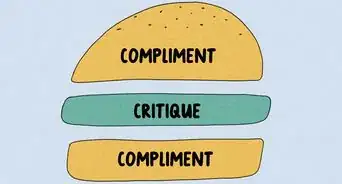









References
- ↑ https://smallbusiness.patriotsoftware.com/how-to-respond-bad-review/
- ↑ https://smallbusiness.patriotsoftware.com/how-to-respond-bad-review/
- ↑ https://smallbusiness.patriotsoftware.com/how-to-respond-bad-review/
- ↑ https://www.forbes.com/sites/ryanerskine/2018/12/31/how-to-respond-to-negative-reviews-including-examples/?sh=f0c6f97534b4
- ↑ https://www.forbes.com/sites/ryanerskine/2018/12/31/how-to-respond-to-negative-reviews-including-examples/?sh=f0c6f97534b4
- ↑ https://www.businessnewsdaily.com/9187-respond-to-online-reviews.html
- ↑ https://learn.g2.com/how-to-respond-to-negative-customer-reviews
- ↑ https://smallbusiness.withgoogle.com/free-google-training/how-to-respond-to-google-reviews/#!/
- ↑ https://sellercentral.amazon.com/gp/help/external/G202126280?language=en_US
About This Article

